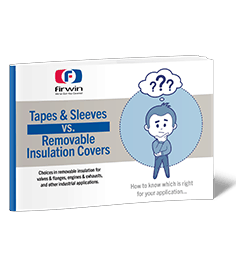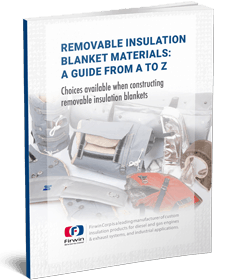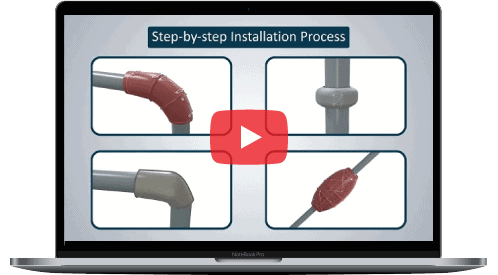At first glance, making up a removable insulation blanket seems somewhat simple – take some insulation, put some mesh on one side, a cover on the other, sew them together, add some rivets so that you can fasten it, and presto!
Of course, we know that in fact it is not quite so simple. Aside from the design aspect –that is ensuring that the insulation blanket fits the part properly, wrapping snugly around the part, and taking into account whatever brackets, screws, and other protrusions might be present – there is the aspect of choosing the appropriate materials with which to manufacture the blanket.
Removable Insulation Blanket Construction
Removable insulation blankets can be divided into 3 main components:
- An outer protective cover—also known as the cold face—designed to shield and protect the insulation from the environment in which it finds itself.
- The insulation mat itself, typically 1″ thick fiberglass, which provides the actual heat containment. Thicknesses vary from ½” up to 4,” depending on the amount of heat reduction the application requires.
- The inner liner—also known as the hot face—which helps to keep the insulation mat in place and may also act as a barrier to protect the insulation mat from fluid seepage.
Aside from these 3 components, there is the fastening system used to secure the insulation blankets in place. The type of fastening used is largely dependent on the type of equipment being covered, the applications for which it will be used, and the environment in which the covered equipment operates. A wide variety of fastening equipment is available for use with removable insulation blankets. Common fastening methods include:

Material and Fastening Options: Typical Engine Exhaust System
Material and fastening options are for example purposes, and do not necessarily correspond to the component indicated.
Use the Interactive Typical Engine Exhaust System Illustration below to learn more about the different materials and fastening options available.

Silencer
Material: Heavy Duty Silicone--This (Heavy Duty) silicone impregnated fiberglass fabric is often used in more severe outdoor applications, and in larger size applications where increased strength and resistance to wear and tear is needed.
Fastening System: Stainless steel lacing wire with rivets
Donut Flange
Material: Teflon Coated Fiberglass - Used interchangeably with Silicone. Used in place of Silicone in Paint, Food, and other chemical applications due to broader chemical resistance.
Fastening System: Stainless Steel Mesh Straps
Mitered Elbow
Material: Aluminized Silicone-Coated Fiberglass—An aluminized high reflective radiant barrier. Flame resistant, shows resistance to water and oils, and mold resistant.
Fastening System: Straps with Clips
Additional Covering
Material: PVC--More economical alternative to Silicone and Teflon where high temperature rating is not required. Water and oil resistant, mold resistant, UV resistant.
Fastening System: Springs
Elbow
Material: Silica--A non-coated fabric used both as an outer cover and inner liner in extreme high temp exposure conditions where silicone and Teflon fabrics are unsuitable.
Fastening System: Snaps
Turbo
Material: Red Silicone Impregnated Fiberglass - similar to our standard Grey silicone outer cover, with a slightly higher (600F vs 500F) temperature rating
Manifold
Material: Grey Silicone Impregnated Fiberglass - Typical outer cover used in most standard insulation blanket applications. Also used as inner liner for applications < 500°F (260°C) where a fluid barrier or insulation fiber containment is desired.
Fastening System: Stainless steel lacing wire with rivets
Applications
Removable insulation blankets are highly versatile and can be customized to fit a variety of equipment in a wide range of applications. They are frequently used to insulate engine components, exhaust systems, and industrial machinery. Sectors such as power generation, on-highway vehicles, mining and marine benefit from the use of insulation blankets in order to manage engine heat.

Contact Firwin for Removable Insulation Blankets
At Firwin, we are proud to provide top-quality removable insulation blankets in a wide range of versatile designs and materials. We understand that each application has different needs, and we take into account all variables to ensure that you have the perfect insulation for your applications.
Whether you are in need of a standard insulation material or a customized blanket to particular specifications, the experts at Firwin are ready to help you choose the correct insulation material or combination for your application. Read our free eBook to learn about everything you should look for in your insulation blanket supplier.
for more information on our superior removable insulation blankets.
Featured Resources
Gain more insight into insulation blankets with three of our most popular eBooks.

Choosing the Right Insulation Blanket Supplier
Download
Tapes & Sleeves vs. Removable Covers
Download

